Home » Rocks » Igneous Rocks » Granite
Granite
What is Granite? What is Granite Used For?
Article by: Hobart M. King, PhD, RPG
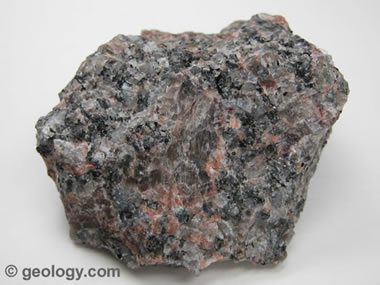
Granite: The specimen above is a typical granite. It is about two inches across. The grain size is coarse enough to allow recognition of the major minerals with the unaided eye or with the help of a hand lens. The pink grains are orthoclase feldspar, and the clear to smoky grains are quartz or muscovite. The black grains can be biotite or hornblende. Numerous other minerals can be present in granite.
What is Granite?
Granite is a light-colored igneous rock with grains large enough to be visible with the unaided eye. It forms from the slow crystallization of magma below Earth's surface.
Granite is composed mainly of quartz and feldspar with minor amounts of mica, amphiboles, and other minerals. This mineral composition usually gives granite a red, pink, gray, or white color with dark mineral grains visible throughout the rock.

Granite in Yosemite Valley: Photograph of Yosemite Valley, California, showing the steep granite cliffs that form the walls of the valley. Image copyright iStockphoto / photo75.
Table of Contents
 What Is Granite? What Is Granite? The Best-Known Igneous Rock The Best-Known Igneous Rock Granite in the Continental Crust Granite in the Continental Crust Definitions of Granite Definitions of Granite Introductory Course Definition Introductory Course Definition Petrologist's Definition Petrologist's Definition Commercial Definition Commercial Definition Uses of Granite Uses of Granite |
The Best-Known Igneous Rock
Granite is the best-known igneous rock. Many people recognize granite because it is the most common igneous rock found at Earth's surface and because granite is used to make many objects that they encounter in daily life. These include countertops, floor tiles, paving stone, curbing, stair treads, building veneer, and cemetery monuments. Granite is used all around us - especially if you live in a large modern city.
 |
Related: Explore the many uses of granite! |
Granite is also well known from its many world-famous natural exposures. These include: Stone Mountain, Georgia; Yosemite Valley, California; Mount Rushmore, South Dakota; Pikes Peak, Colorado; and White Mountains, New Hampshire.
Yosemite Nature Notes - Granite: This video examines some of the granites that create the scenic and climbing pleasures of Yosemite National Park.
Granite in the Continental Crust
Introductory geology textbooks report that granite is the most abundant rock in the continental crust. At the surface, granite is exposed in the cores of many mountain ranges, within large areas known as "batholiths," and in the core areas of continents known as "shields."
The large mineral crystals in granite are evidence that it cooled slowly from molten rock material. That slow cooling had to have occurred beneath Earth's surface and required a long period of time to occur. If these granites are exposed at the surface today, the only way that could have happened is if the granite rocks were uplifted and the overlying rocks were eroded.
Most parts of Earth's continents are covered with sediments or sedimentary rocks. The rocks below are usually granites, metamorphosed granites, or closely related rocks. These deep granites are often referred to as "basement rocks."

Granite: Photograph of a white, fine-grained granite. Many of the grains in this rock can be seen with the unaided eye - especially the black grains. However, the white grains are difficult to see with the unaided eye because their boundaries are difficult to recognize - even with help from a hand lens. This rock might be called an aplite because of its fine grain size. This specimen is about two inches across.

Granite close up: Magnified view of the white, fine-grained granite from the photograph above. You can see how it is difficult to recognize the boundaries between the light-colored grains - even with the help of magnification. The area shown in this image is about 1/4 inch across.
Multiple Definitions of Granite
The word "granite" is used in a variety of ways by different people.
A simple definition is used in introductory geology or earth science courses.
A more precise definition is used by petrologists (geologists who specialize in the study of rocks).
And, the definition of granite expands wildly when used in the crushed stone and dimension stone industries.
These multiple definitions of granite can lead to communication problems. However, if you know who is using the word and who they are communicating with, you can interpret the word in its proper context. Three common usages of the word "granite" are explained below.

Generalized Composition Ranges of Common Igneous Rocks: This chart illustrates the generalized mineral composition of igneous rocks. Granites and rhyolites (compositionally equivalent to granite but of a fine grain size) are shown on the left side of the chart. From this diagram you can tell: granites are composed mainly of orthoclase feldspar, quartz, plagioclase feldspar, mica, and amphibole; and, the orthoclase component can range in abundance from as little as 10% of the rock up to about 75% of the rock.
A) Introductory Course Definition
Granite is a coarse-grained, light-colored igneous rock composed mainly of feldspars and quartz; it also contains minor amounts of mica and amphibole minerals (see the accompanying chart titled Generalized Composition Ranges of Common Igneous Rocks). Once students know how to identify the minerals in granite, this simple description enables them to identify the rock based upon a visual inspection.
During that visual inspection, students should use a hand lens to confirm that the minerals of granite are present in the rock. That inspection would involve confirming that each of the minerals expected in granite is physically present in the rock - and present in the proper proportion.
Here is a summary of what you might observe on a broken surface of granite:
 |
Did You Know? A Hand Lens is an important tool for learning about rocks. The minerals in a rock must often be identified to determine the rock's name. |
Feldspar Minerals
Feldspar minerals are abundant in granite. They are usually white, gray, pink or reddish in color. Many grains will exhibit two directions of cleavage that intersect at right angles. You should be able to observe this cleavage pattern in granite with a hand lens.
Quartz
Quartz will usually be a transparent mineral that is colorless or gray in color. Many grains will exhibit a conchoidal fracture - with a vitreous luster on the conchoidal fracture surfaces.
Mica Minerals
The mica minerals expected in granites include muscovite or biotite. Micas occur in very thin sheets. They will often be in "books" of numerous sheets stacked upon one another. The surfaces of these sheets will have a highly reflective vitreous luster. The edges of a "stack of sheets" will look similar to the edge of a stack of playing cards.
Amphibole Minerals
Amphibole minerals such as hornblende are dark in color and will often have a prismatic habit.
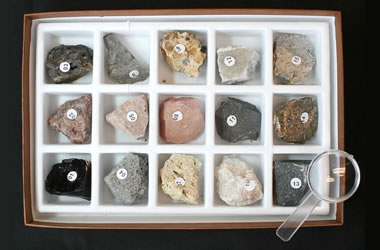
Rock & Mineral Kits: Get a rock, mineral, or fossil kit to learn more about Earth materials. The best way to learn about rocks is to have specimens available for testing and examination.
B) Petrologist's Definition
Granite is a plutonic rock in which quartz makes up between 10 and 50 percent of the felsic components. Alkali feldspar accounts for 65 to 90 percent of the total feldspar content. Applying this definition requires the mineral identification and quantification abilities of a competent geologist.
This type of analysis cannot be done precisely by a student in a classroom or a geologist in the field. This is an example of the complexities that can be involved in assigning a formal name to an igneous rock.
Many rocks identified as "granite" using the introductory course definition will not be called "granite" by the petrologist. They might instead be alkali granites, granodiorites, pegmatites, or aplites. These names are for specific types of granite.
These names require a consideration of the grain size and the mineral composition of the rock - beyond determining that the rock is a granite. A petrologist might call these "granitoid rocks" rather than granites. There are many types of granite based upon mineral composition and texture.
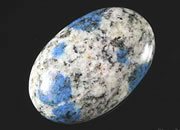 |
Did You Know? Azurite Granite, also called "K2 granite," is often cut into gems. People enjoy its blue and white colors. |
The accompanying chart (Generalized Composition Ranges of Common Igneous Rocks) illustrates the range of granite compositions. From the chart you can see that orthoclase feldspar, quartz, plagioclase feldspar, micas, and amphiboles can each have a range of abundances.
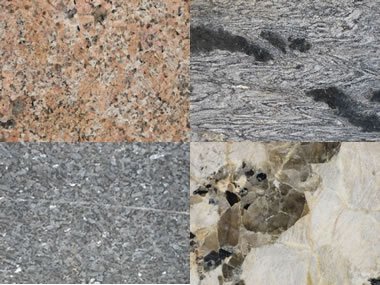
"Granite": All of the rocks above would be called "granite" in the commercial stone industry. Using the terminology of geologists, they would be (clockwise from top left): granite, gneiss, pegmatite, and labradorite. Click on any of their names above for an enlarged view. Each of the images above represents a slab of polished rock about eight inches across.
C) Commercial Definition
Use of the word "granite" in the dimension stone and crushed stone industries is different from how the word is used by geologists. In these industries, the name "granite" refers to an igneous rock that meets the following criteria:
1) a rock with visible grains that interlock with one another
2) a rock that is harder than marble
Using these criteria, gabbro, basalt, pegmatite, schist, gneiss, diabase, diorite, and many other igneous rocks will be called "granite."
These "granites" are used to make crushed stone that is used for highway construction, concrete, building construction, fill, railroad ballast, and many other purposes. They are used in the dimension stone industry to make countertops, floor tiles, curbing, building veneer, monuments, paving stones, and many other products. These granites might be used with sawn, sheared, or polished surfaces.
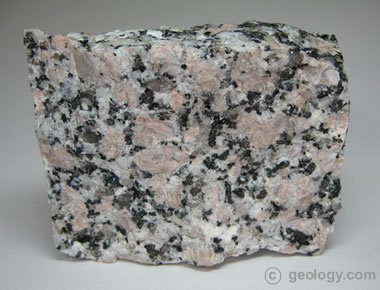
Pegmatite: Photograph of a granite with very large crystals of orthoclase feldspar. Granites composed mainly of crystals over one centimeter in diameter are known as "pegmatites." This rock measures approximately four inches across.
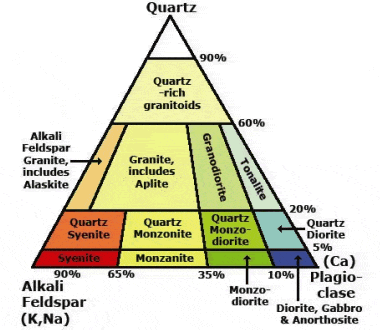
Granitic rocks: This triangular diagram is a classification method for granitic rocks. It is based upon the relative abundance of feldspars (K-Na-Ca) and quartz. Mafic elements are not considered. It is modified after a classification chart prepared by the International Union of Geological Sciences. Image and modification by the United States Geological Survey.
When "Granite" Is Inadequate
So, the name "granite" is a name used for igneous rocks that are composed of orthoclase feldspar, quartz, plagioclase feldspar, micas, and amphiboles that are present in crystals large enough to be visible with the unaided eye.
That name isn't specific enough for some purposes and for some people.
Special names are used for granitic rocks based upon their grain (crystal) size. If a granitic rock has especially large grains (over one centimeter across), it is often called "pegmatite." If it is an especially fine-grained rock from crystallizing at a shallow depth, it might be called "aplite."
Granitic rocks that have a mineral composition that borders upon diorite might be called "granodiorite." Those especially rich in plagioclase feldspars, at the expense of alkali feldspars, might be called "monzodiorites."
The accompanying triangular diagram displays a classification method used for granitic rocks based upon the relative abundances of quartz, alkali feldspars, and plagioclase feldspars. This is not a chart for use by the beginning student of igneous rocks. It is a classification used by experts who have the skills and equipment needed to quantify the mineral composition of the rock.

Granite Countertops: Granite countertops in a new kitchen. Image copyright iStockphoto / Bernardo Grijalva.

Mount Rushmore: Mount Rushmore in the Black Hills, South Dakota is a sculpture of United States presidents George Washington, Thomas Jefferson, Theodore Roosevelt, and Abraham Lincoln sculpted from a granite outcrop. Image copyright iStockphoto / Jonathan Larsen.
Uses of Granite
Granite is the rock most often quarried as a "dimension stone" (a natural rock material that will be cut into blocks or slabs of specific length, width, and thickness). Granite is hard enough to resist abrasion, strong enough to bear significant weight, inert enough to resist weathering, and it accepts a brilliant polish. These characteristics make it a very desirable and useful dimension stone.
 |
Related: Explore the many uses of granite! |
Most of the granite dimension stone produced in the United States comes from high-quality deposits in five states: Massachusetts, Georgia, New Hampshire, South Dakota, and Idaho.
Granite has been used for thousands of years in both interior and exterior applications. Rough-cut and polished granite is used in buildings, bridges, paving, monuments, and many other exterior projects. Indoors, polished granite slabs and tiles are used as countertops, floor tiles, stair treads, and many other practical and decorative features.
High price often reduces the popularity of a construction material. Granite often costs significantly more than man-made materials. However, granite is frequently selected because it is a prestige material, used in projects to produce impressions of elegance, durability, and lasting quality.
Granite is also used as a crushed stone or aggregate. In this form it is used as a base material at construction sites, as an aggregate in road construction, railroad ballast, foundations, and anywhere that a crushed stone is useful as fill.
| More Rocks |
 |
The Rock Used to Make Beer |
 |
Geodes |
 |
Gifts That Rock |
 |
Azurite Granite? |
 |
Tumbled Stones |
 |
Flint, Chert, and Jasper |
 |
Fossils |
 |
Fluorescent Minerals |

Find Other Topics on Geology.com:

|

| ||

|

| ||

|

| ||

|

|
